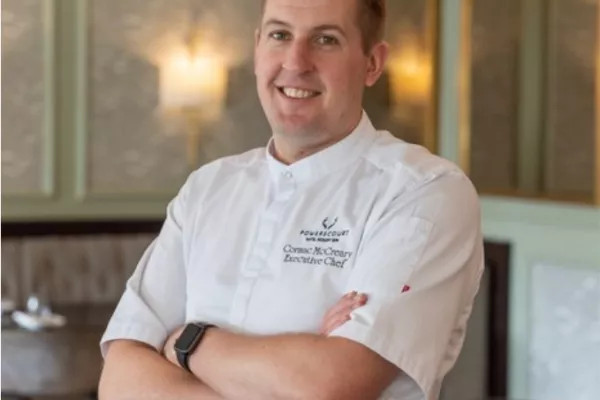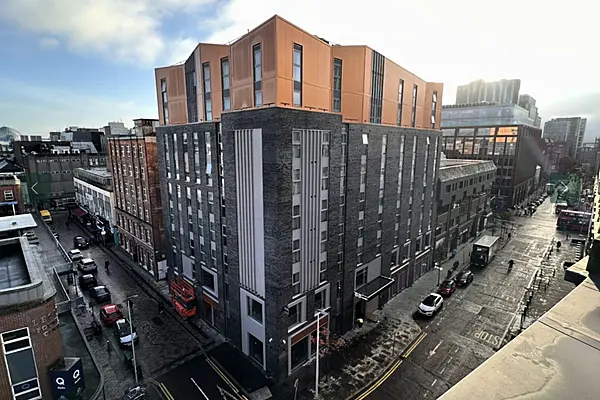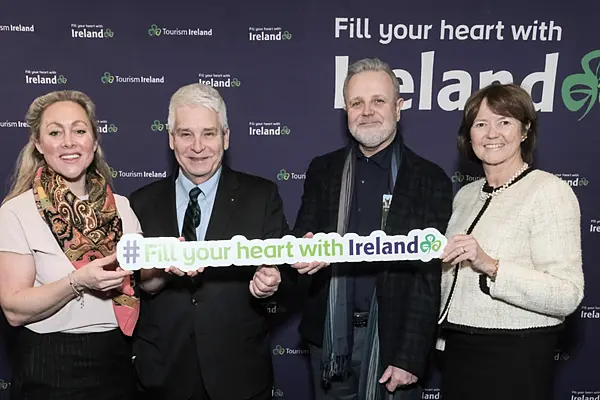Cormac Mc Creary, executive chef at Powerscourt Hotel Resort & Spa, speaks to Robert McHugh about earning his stripes in some of the most famous dining establishments in the world.
Cormac Mc Creary has a resume that most chefs can only dream about.
The executive chef at Powerscourt Hotel Resort & Spa has a career that spans over 20 years, with experience at some of the most highly respected culinary establishments across Europe.
Dublin-born Mc Creary began his career at a young age, at the K Club, where chef Finbar Higgins took him under his wing, training him from scratch and developing his cooking skills over five years. Leaving as a junior sous-chef, he joined Gordon Ramsay’s team for the opening of his restaurant at Powerscourt in 2007.
Knowing that his career would benefit from some overseas experience, he moved to London, to work at the acclaimed one-Michelin-starred Read’s Restaurant, and then with prestigious chef Michael Caines for three years.
He then decided to sharpen his skills by moving to the Ritz London, under renowned executive chef John Williams MBE. At this famous establishment, Mc Creary became an integral part of the sous-chef team that achieved a long-awaited Michelin star for the restaurant.
Prior to his role at Powerscourt, he was executive chef at Mount Juliet Estate, in Kilkenny.
Tell us about your background – where you grew up, studied, etc.
I grew up in Celbridge and went to school at Salesian College, and from there I went to DIT in Cathal Brugha Street, and I studied professional cookery.
That was the educational side.
What first drew you to food and cooking?
Firstly, it was the buzz of the kitchen. I got a job in the local pub, as a kitchen porter, and it was fun and good craic. I did not really enjoy school.
The pub, one Saturday, asked me if I would I cover for one of the chefs, who was away. It became a weekly thing. Every Friday, I would go in after school and be a chef, and I fell in love with it.
From there, I got a job at the K Club.
Is that the moment when you knew that you wanted to do it professionally?
Yes, it was, but I was probably a bit naïve, thinking that all kitchens are run that way. No disrespect – they were businessmen, and they made a lot of money in that pub, but I don’t think I would have fallen in love with that side of it for the rest of my life.
It was more the atmosphere that grabbed me. Kitchens can be good fun – a bit of a laugh, different to school. It’s not regimented, where you sit in a chair and don’t move. The kitchen life was popping out for a smoke and going for a drink afterwards. I fell in love with the lifestyle.
From there, I had a cousin in the K Club, so I got a job there as an apprentice. That’s where I fell in love with the food side of it. That’s where I learned what cooking is and what it’s about.
Finbar Higgins was the head chef when I started. At the time, the K Club had the Ryder Cup, the European Open, and loads of other big events. There were only a few hotels that could match it then, such as the Four Seasons and the Merrion. It was always full of celebrities, it had five-star food, and that’s where I fell in love with food and cooking.
Maybe not at the start, though – it was hard work and a tough kitchen. It was old school – there was no messing about. It was before iPhones and Instagram. If you wanted to learn a recipe, you had to work at it.
Was this during the Celtic Tiger years?
It was 2002 when I started at the K Club. We had members like JP McManus and Dermot Desmond. [Michael] Smurfit would often have dinner there. I met Bill Clinton, George Bush Sr, Liam Neeson – Michael Flatley was there on a weekly occasion. Oasis and the Spice Girls were there. It was a high-end market.
What was it like meeting George Bush Sr?
(Laughs) Well, it was quite fast, really. They had all these Secret Service agents come in. Every time he moved, the Secret Service were five steps ahead of him. There was a Secret Service agent at each door, and there are three doors going into the kitchen, so three agents all lined up. He comes in, a quick shake of the hand, and moves on. You don’t really get a word in.
Talk to us about your career highlights so far.
I worked in the Ritz in London. It was an old-school kitchen as well. You could be working 15 to 17 hours a day. It was a big operation, and you worked many hours.
There was no head chef at the time, so it was like a brigade. There were six sous-chefs. We were awarded the Michelin star when I was working there as a sous-chef. That was probably my career highlight.
Six chefs?! The old saying comes to mind, about too many chefs …!
It was just such a big environment. We had 400 for afternoon tea daily, 130 Michelin-star dinners to be cooked that night. We didn’t have big banquets, but we might have three or more small banquets, in forties and fifties. The food that was delivered to those banquets was à-la-carte food – it was a lot of preparation. Everything was made in house, with 25 pastry chefs making 1,200 scones every day. It was a good learning experience.
I went in there as a cook and came out as a chef. It was a collective effort. There was an executive chef there, but only three sous-chefs there at a time. One might finish early, and another might come in later, and that type of thing.
There were sous-chefs arriving from two-star restaurants coming into that environment. Michael Nizzero had his own Michelin-star restaurant in France for four years, and he came in as a sous-chef. He is now the executive chef of the Roux Brothers’ restaurant.
Tom Scade was part of that team. He is now working in the Vineyard, in England, as the executive chef.
Ian Musgrave just represented the UK in the Bocuse d’Or, the biggest cooking competition in the world.
Spencer Metzger is going to open a restaurant for Jason Atherton.
John Williams, executive chef of the Ritz, won AA [Chefs’] Chef of the Year and Chef of the Year at the Cateys. I cooked with John Williams in July – he asked his alumni members to come back to help. Michael was there, Tom, Ian, and Adam Byatt from the Michelin-starred Trinity restaurant was there. Noel McNeil, the group executive [chef] for the Dorchester Collection, was also there, along with Tom Phillips, the head chef of Restaurant Story, and Adam Smith, head chef of Coworth Park.
It was great to be thought of in that same group. It was a tough environment, but the cream really rose to the top in that atmosphere.
Tell us about the food at the Sally Gap Bar & Brasserie at Powerscourt – the ethos, sourcing, etc.
We try and use as much produce as we can from Wicklow. We use John Stone beef and Wicklow Ridgeway Wagyu beef for the burgers.
It’s a family-friendly environment. There is food here for everyone, for all palates.
What makes a great restaurant?
Consistency. You have to deliver. You have to excel in all departments. It’s not just about the food – it’s the service that guests receive from the minute that they walk in the door.
What are the changing trends in hospitality – people’s expectations, new elements, etc.?
Social media has changed people’s expectations. People have more of an opinion. It can be difficult in a hotel because we are different to a stand-alone restaurant. If you book into a restaurant – an Italian restaurant, for example – you know you are getting Italian food.
When we receive guests that come here to eat, they are coming in because they are staying in the hotel. They might not necessarily be foodies.
The hardest part for our restaurant is to please all guests. We can’t just say, “This is what we want to do, and we are doing this, and that’s it.”
We are part of a hotel, so it is slightly different than a traditional restaurant.
So you must cater to a wider set of tastes?
The Sally Gap fits all parts. It’s hard to do that with a fine-dining restaurant. Some people just consider a good meal as getting well fed. There is a younger crowd now that know what good food is, and they go out and eat in different restaurants. They want that service when they come here, and they want us to deliver that.
You have to be careful with how you design your menu and how it fits in with the type of restaurant you want to be.
What are the major challenges at the moment?
Staffing. I think, after Covid, there is a massive gap in the market. It’s all well and good getting chefs in at the moment, but they have no training and no experience.
Many good chefs have left the industry, but even with the new chefs coming in, there is a gap in knowledge and training. That gap is the hardest part to fill.
From our side, we have about six apprentice commis chefs at present, so we are busy bringing them through the ranks.
What are the main opportunities?
The trend towards being green and more sustainable. Also, more restaurants are looking for local produce and suppliers, which is a really good initiative and great for hotels.
It’s all well and good if the chef wants to move in that direction, but if the hotel wants to cut costs, that’s tough – but if the hotel buys into it, that’s fantastic. It’s good to support the local community, and you get a better product. You get introduced to different suppliers, and it expands.
We have a guy that does our honey now. We have 25 different hives on Powerscourt Estate. He introduced us to someone else that supplies Dexter beef. It’s a small network that builds up.
Any other plans on the horizon for the next year or so?
After getting Sally Gap opened and running consistently, our next push will be our Sika fine-dining restaurant. We really want to show off what Wicklow has to offer.
At the moment, we are missing small items, like a tasting menu to represent Wicklow and the seasonal produce Ireland has to offer. There is a lot of work to do from all sides to get it right, but we have some good people here, and I am confident we can get it there.
We will start with a Sunday lunch offering in the first quarter of next year in Sika, with traditional roast beef and Yorkshire puddings and all the trimmings.
What is your favourite pub?
There is a pub called Crowley’s in Kenmare, Kerry – not much seating, and you have to stand a lot of the time, but’s it great craic, and there’s always a sing-song.
What is your favourite meal?
Beef Wellington.
What is your favourite drink?
Heineken.
Your favourite holiday destination?
Anywhere there is sun.
Name one thing that you always have in your fridge.
Irish butter.







